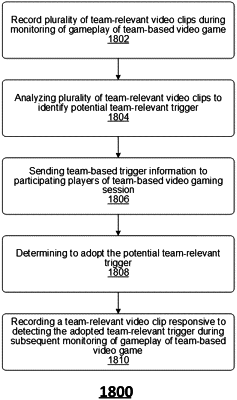| CPC A63F 13/497 (2014.09) [A63F 13/5378 (2014.09); A63F 13/79 (2014.09); A63F 13/798 (2014.09); A63F 13/86 (2014.09); A63F 13/28 (2014.09); A63F 13/35 (2014.09); A63F 13/355 (2014.09); A63F 13/54 (2014.09); A63F 13/69 (2014.09); A63F 13/843 (2014.09); A63F 13/847 (2014.09); A63F 13/85 (2014.09); A63F 13/95 (2014.09); A63F 13/98 (2014.09); A63F 2300/408 (2013.01); A63F 2300/537 (2013.01); A63F 2300/538 (2013.01); A63F 2300/558 (2013.01); A63F 2300/5546 (2013.01); A63F 2300/634 (2013.01); G06N 20/00 (2019.01); H04L 51/046 (2013.01); H04L 51/10 (2013.01); H04L 51/52 (2022.05); H04L 67/06 (2013.01)] | 20 Claims |

|
1. A device, comprising:
a memory to store instructions; and
a processor coupled to the memory, wherein responsive to executing the instructions, the processor performs operations comprising:
accessing training game content;
acquiring one or more machine learning techniques based on the training game content that is accessed;
analyzing a first plurality of team-relevant video clips associated with a first participating team of a first team-based video gaming session, wherein the first team-based video gaming session is associated with a team-based video game, wherein the analyzing is performed via use of the one or more machine learning techniques that are acquired, and wherein the analyzing determines a team-relevant trigger associated with the first participating team;
receiving a second plurality of team-relevant video clips associated with the first participating team of a second team-based video gaming session of the team-based video game responsive to identifying the team-relevant trigger associated with the first participating team in the second team-based video gaming session;
comparing a first performance of the first participating team of the second team-based video gaming session and a second performance of a second participating team of the second team-based video gaming session according to the second plurality of team-relevant video clips to generate an assessment of the first performance of the first participating team;
determining a beneficial strategy for the first participating team based on the assessment of the first performance of the first participating team and a target gaming result collectively beneficial to the first participating team;
generating team-based first strategy information for a first player of the first participating team and team-based second strategy information for a second player of the first participating team according to the beneficial strategy, wherein the team-based first strategy information differs from the team-based second strategy information; and
providing the team-based first strategy information for the first player of the first participating team to equipment utilized by the first player of the first participating team.
|